Experiential Graphic Design, or EGD, is used in a variety of spaces, like the middle school featured below, to enhance the user experience, provide innovative wayfinding, and tell a story. In Yelm Middle School, EGD was used to encourage student learning in engaging and immersive ways and anchor the students in the historical context of both their school and the land on which it sits.
The 100,000 SF Yelm Middle School is a state-of-the-art educational facility that accommodates 725 students. The new school honors its heritage and the surrounding community through intentional and holistic design. Experiential graphics were inspired and informed by the nearby Native American Nisqually Tribe, honoring the school’s location on native land and the people who have stewarded and preserved that land for centuries.
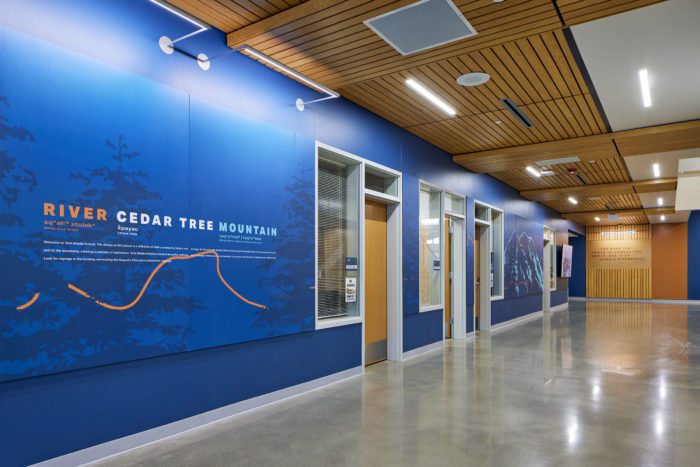
With design drivers like reflection, exploration, history, hope, pride, adaptability, and resiliency, Yelm Community Schools wanted to ensure their new middle school would honor its history, reflect its community, and proudly stand the test of time. These values are highlighted in an excerpt directly from the design concept statement, shown in an EGD feature at the school’s entry: “The design of this school is a reflection of Yelm’s community, history, and ecology. As this area was settled, tribes moved along the Nisqually River, through cedar tree forests, and to the mountains, creating a pathway of exploration. Yelm Middle School is located along that pathway and its design references the environment, the people, and the spirit of adventure that defines Yelm.”
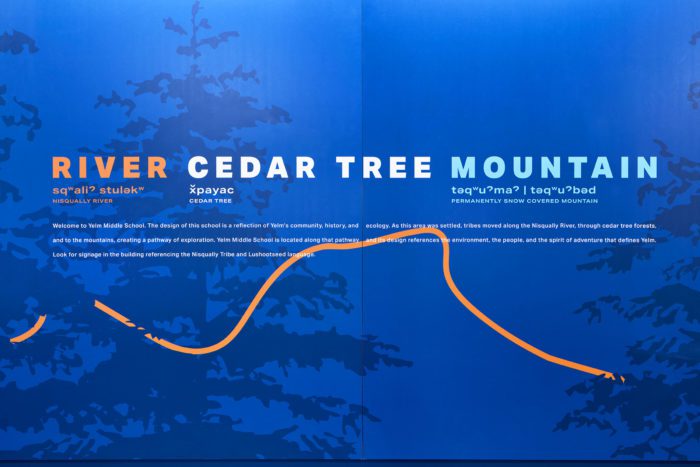
To accurately honor the school’s rich history and sense of place, designers met with the Nisqually Tribe early in the design process to ensure their voice was heard as the replacement school was designed and constructed. They described the significance of Mt. Rainier, the water (Nisqually River and Salish Sea), the cedar tree, and prairie grass in Nisqually history. Their invaluable insight into the land and its best features helped shape the design—especially the experiential graphics that now line the hallways and feature their native Lushootseed translations for key graphic design elements. These graphics keep students grounded in the Nisqually legacy by reminding users that the school resides on indigenous territory. Beyond that, students are also given the opportunity to explore the native language of the area while it is being preserved for future generations.
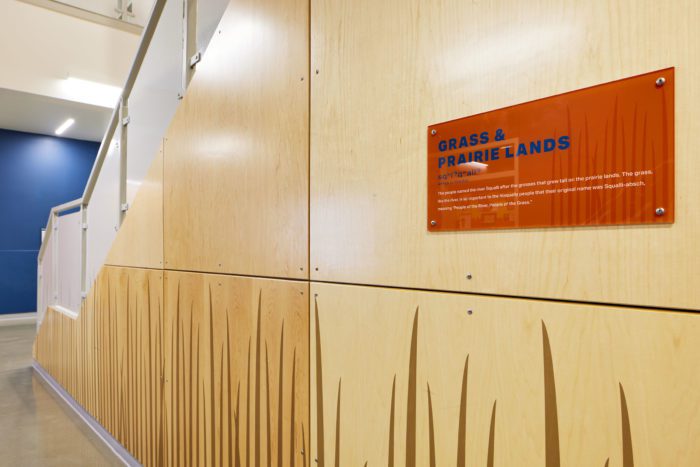
Paying tribute to the history of the city of Yelm was also important to the stakeholders in the project. Experiential graphics highlight the history of the city and its inextricable ties to the Nisqually Tribe.
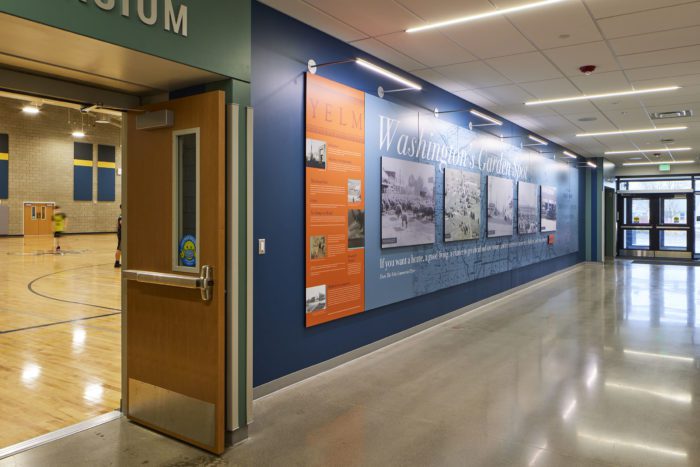
After three failed attempts, the citizens of Yelm passed a bond promising to replace aging schools, improve safety, and expand community use. The Yelm Middle School replacement project was the first step in delivering those promises to voters.
To that end, design always kept the final users in mind: the students, the staff, and the community. Students, led by school administrators, selected several key motivational design elements, both inside and outside the building. For example, the students picked a quote by an unknown author that reads, “You have the power to change the world. Use it to make a difference.” The design was formatted to highlight the city’s name in red.
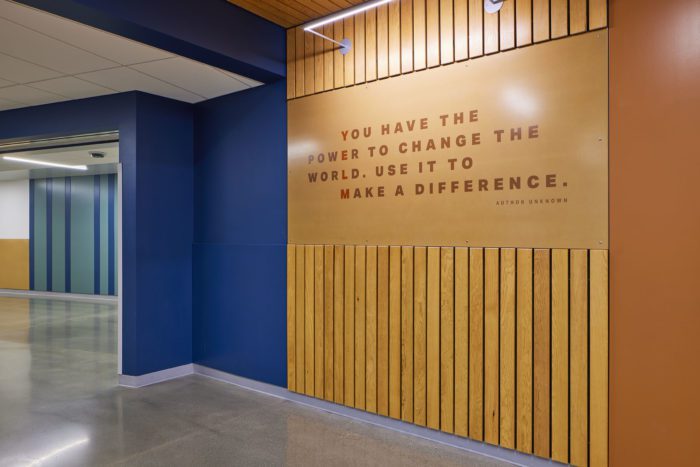
EGD is often intentionally placed in highly visible areas so the school’s funds make the most impact, potentially serving more than one use. For example, the wall along the main staircase needed protection due to its location in a high traffic area, so designers used that opportunity to create the two-story mountain feature below, blending beauty and function.
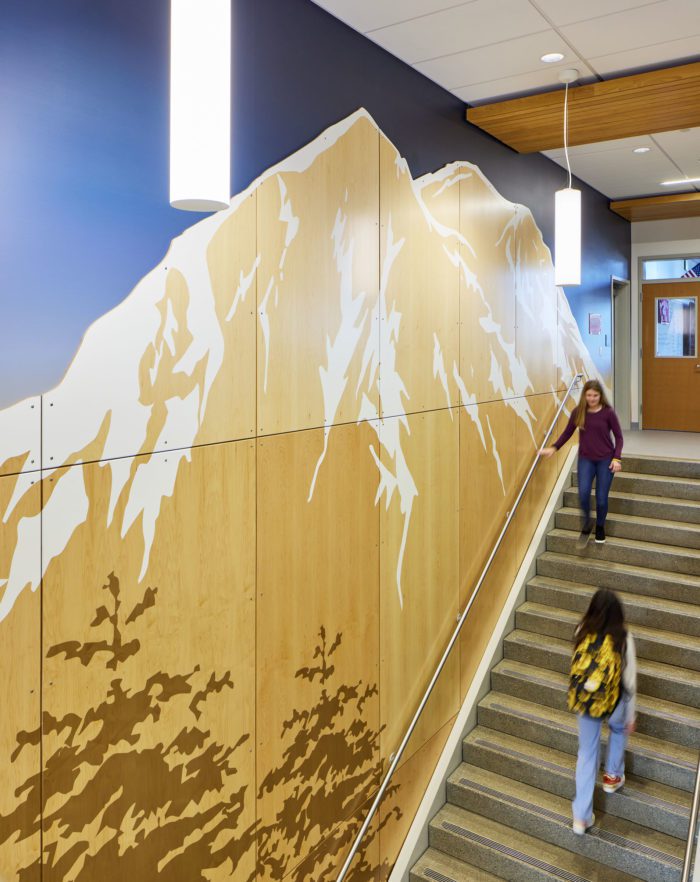
Yelm Middle School also incorporated six biophilic design concepts throughout—Sunlight, Prospect and Refuge, Botanical Motifs, Geographic Connection, Spaciousness, and Sensory Variability. These are applied in many ways throughout the school. Experiential graphic design showed this best by incorporating biophilic elements in a variety of engaging and meaningful ways: the warmth of the wood finishings used throughout the school, large-scale botanical illustrations that often surround from every angle, connections to the local natural landscape with the eye-catching mountain feature along the main staircase, prairie grass designs along hallways and handrails, ample use of the color blue and wavy patterns that echo the Nisqually River, and a combination of subtle and bold colors to create depth and stimulating focal points that foster student creativity and learning.
The Nisqually Tribe also chose to honor their partnership with the school by offering a traditional blessing at the ribbon cutting ceremony. Better than perhaps any other measurement could, this gesture of friendship and goodwill defined the success of the project and made those involved proud to be a part of the process.
Our experiential design approach helps bring a brand to life. Our interior designers, architects, and experiential graphic designers elevate the user experience through experiential graphics, finish materials, wayfinding elements, signage, and identity systems. Experiential graphic design, when done right, gives the user a unique experience they can’t find anywhere else.